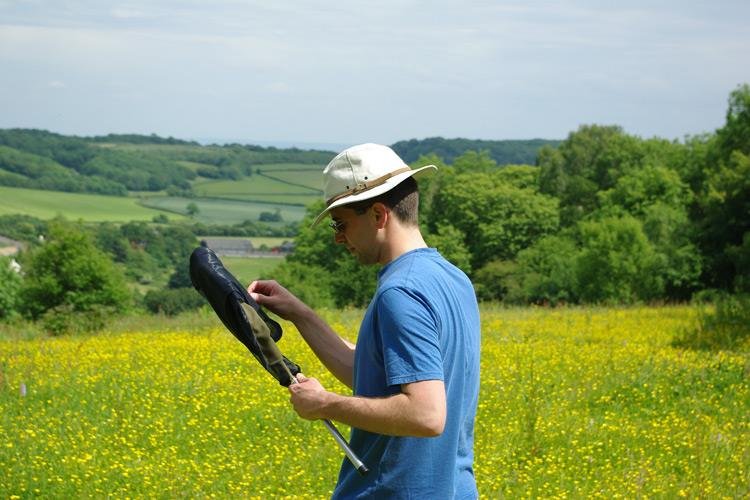Many organisations in Wales provide ecological training. The courses cater for professional development and personal interest. Click on the links for further information.
Wildlife Recording
There are many national wildlife surveys happening all over the UK that you can take part in whether you are interested in bugs, plants, reptiles, amphibians, mammals or birds.
It is possible to make useful records with no specialist knowledge. If you are unsure of your identification, your Local Record Centre can help to put you in touch with a local expert. Don't forget to send your sightings to the Local Environmental Record Centre. This helps strengthen our evidence base for nature protection and recovery.
Local Record Centres are interested in receiving records of all species, no matter how common or widespread
Nature surveys and campaigns are a great way to engage with nature and you will be making a real difference by taking part. Find out what's happening throughout the year using our calendar of events and Woodland Trust's "Signs of the Season".
Ancient Tree Hunt
Ancient trees are living relics of incredible age that inspire in us feelings of awe and mystery. The Ancient Tree Hunt (ATH) is a living database of ancient trees which began in 2004 and to date has recorded over 100,000 across the UK. The tree information you record can be used locally or nationally to highlight the importance of trees, promote their value and encourage their conservation. Find details of ancient trees near where you live or places that you visit frequently using the Ancient Tree Map. There are still lots of amazing ancient trees still to be discovered and recorded. If you find a tree that is not on the map then you can add it and upload an image as well. The growing database will give us a much better understanding of the number of ancient trees across the UK. Recording them is the first step towards cherishing and caring for them.
Citizen Science is about partnership- bringing together scientists, amateur recorders and local interest groups from a variety of backgrounds to observe and record the state of our environment.
Featured Surveys
There are a number of surveys you can take part in covering a wide range of species and some habitats. Some are listed below- your Local Record Centre in Wales has a comprehensive list of surveys on your patch as well as national surveys.
Bugs Matter is a nationwide bug hunt to help BugLife investigate how the built environment affects invertebrates.
The BeeWalk Survey
BeeWalk is the national recording scheme run by Bumblebee Conservation Trust (BBCT) to monitor the abundance of bumblebees across the UK. These transects would be impossible without volunteers, who identify and count the bumblebees they see on a monthly walk along a set route from March to October.
Find out more and how you can take part here
The Great British Hedgerow Survey
The survey has been designed for both land mangers that may want to improve the structural condition of their own hedgerows, but also for interested wildlife groups that want assess the quality of habitat in any particular area.
Find out more here
The UK glow work survey aims to gather information about a fascinating insect that most people don’t even realise exists in Britain.
Resources
The Ancient Tree Hunt is a living database of ancient trees in the British Isles- join in and record trees on your patch
Local Record Centres (see below)
Network of wildlife recording centres covering the whole of Wales offering useful advice, events and resources
Wales has four Local Environmental Records Centres (LERCs) and each forms part of the first national network of LERCs (LERC Wales) anywhere in the UK. LERCs reflect the importance of observing and recording wildlife, with the creation of a record being the starting point for all data. LERCs then bring together all these individual records into a centralised database which holds approximately 9 million records, allowing a better understanding of the environment and influences decisions we take where we live. To view a summary of wildlife sightings in your area collated by LERC Wales or view a species distribution map, go to the Biodiversity Information Reporting Database (Aderyn)
National Biodiversity Network
The National Biodiversity Network (NBN), a collaborative partnership, champions the sharing of biological data in the UK. The NBN collates and aggregates data on species and habitats from a wide range of partners, including the Welsh Local Environment Record Centres. Data shared through the NBN are made available through the NBN Atlases.
NBN Atlas Wales
The NBN Atlas is a free online tool that provides a platform to engage, educate and inform people about the natural environment. It brings together species and habitat data to provide an evidence base for environmental decision-making in the UK. The NBN Atlas Wales, a sub-site of the NBN Atlas which covers the British Isles provides a Welsh view. The NBN Atlas Wales can be used to explore and analyse species and habitat information in Wales - you can view species distribution maps, explore an area, view images and much more.
WBP Project funding
WBP works with the 4 Welsh LERC's to help fund wildlife recording courses to increase the number of biological records in Wales.

